java考试题
java考试试题及答案
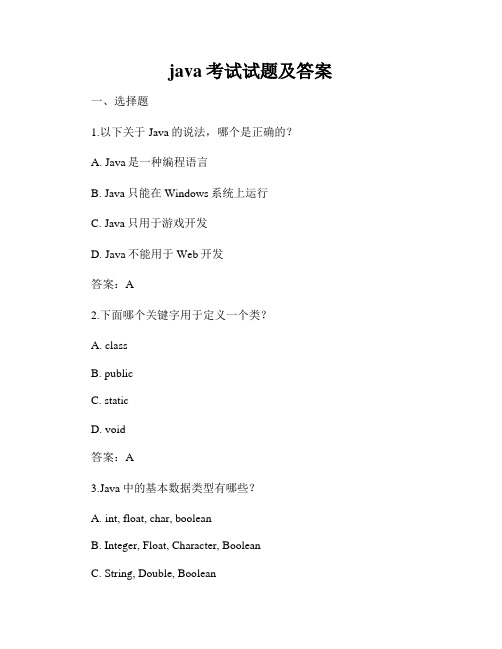
java考试试题及答案一、选择题1.以下关于Java的说法,哪个是正确的?A. Java是一种编程语言B. Java只能在Windows系统上运行C. Java只用于游戏开发D. Java不能用于Web开发答案:A2.下面哪个关键字用于定义一个类?A. classB. publicC. staticD. void答案:A3.Java中的基本数据类型有哪些?A. int, float, char, booleanB. Integer, Float, Character, BooleanC. String, Double, BooleanD. int, double, String, boolean答案:A4.以下哪个不是Java的访问修饰符?A. publicB. protectedC. privateD. final答案:D5.以下哪种循环结构在未知条件的情况下会被循环执行?A. for循环B. while循环C. do-while循环D. switch语句答案:C二、填空题1.Java中用于接收用户输入的类是__Scanner__。
2.Java中String类的equals()方法用于比较两个字符串的__内容__。
3.在Java中,用于创建对象的关键字是__new__。
4.Java中的集合类是位于__java.util__包下的。
5.Java中的逻辑与运算符是__&&__,逻辑或运算符是__||__。
三、简答题1.请简要介绍Java的特点及优势。
Java是一种跨平台的编程语言,具有以下特点和优势:- 简单易学:Java语法相对简单,与C++相比更容易上手。
- 面向对象:Java支持面向对象编程,具有封装、继承和多态的特性。
- 平台无关性:Java通过虚拟机实现跨平台,只需编写一次代码即可在不同操作系统上运行。
- 安全性:Java有严格的访问控制和内存管理机制,可防止非法访问和内存泄漏。
Java考试题

1.下列关于计算机系统和Java编程语言的说法,正确的是(C)A.计算机是由硬件、操作系统和软件组成,操作系统是缺一不可的组成部分。
B.Java语言编写的程序源代码可以不需要编译直接在硬件上运行。
C.在程序中书写注释不会影响程序的执行,可以多写一些详细的注释。
D.Java的集成开发环境(IDE),如Eclipse,是开发Java语言必需的软件工具。
2.下列选项中符合Java命名规则的标识符是(D)A.2japro B. &Class C. const D. _1233.下列在Java语言中关于数据类型和包装类的说法,正确的是(B)A.基本(简单)数据类型是包装类的简写形式,可以用包装类替代基本(简单)数据类型。
B.long和double都占了64位(64bit)的存储空间。
C.默认的整数数据类型是int,默认的浮点数据类型是float。
D.和包装类一样,基本(简单)数据类型声明的变量中也具有静态方法,用来完成进制转化等。
4.下面赋值语句中正确的是(A)A.double d=5.3e12;B. float f=11.1;C.int i=0.0;D. Double oD=3;5.如果int x=20, y=5,则语句System.out.println(x+y +""+(x+y)+y); 的输出结果是(D)A.2530B. 55C. 2052055D. 252556.如下Java语句double x=2.0; int y=4; x/=++y; 执行后,x的值是(C)A.0.5B. 2.5C. 0.4D. 2.07.下列关于Java语言中String和char的说法,正确的是(C)A.String是Java定义的一种基本数据类型。
B.String是以“\0”结尾的char类型的数组char[]。
C.使用equals()方法比较两个String是否内容一样(即字符串中的各个字符都一样)。
大学java考试题及答案详解
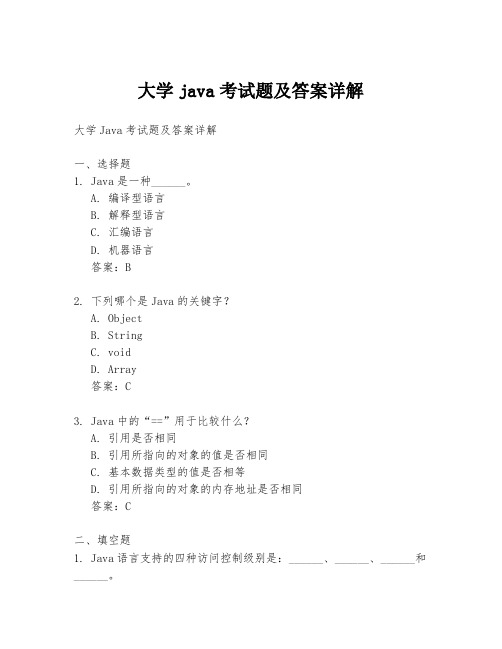
大学java考试题及答案详解大学Java考试题及答案详解一、选择题1. Java是一种______。
A. 编译型语言B. 解释型语言C. 汇编语言D. 机器语言答案:B2. 下列哪个是Java的关键字?A. ObjectB. StringC. voidD. Array答案:C3. Java中的“==”用于比较什么?A. 引用是否相同B. 引用所指向的对象的值是否相同C. 基本数据类型的值是否相等D. 引用所指向的对象的内存地址是否相同答案:C二、填空题1. Java语言支持的四种访问控制级别是:______、______、______和______。
答案:public, protected, default, private2. Java中,______关键字用于定义一个类可以被继承。
答案:extends三、简答题1. 简述Java的垃圾回收机制。
答案:Java的垃圾回收机制是一种自动内存管理功能,它通过垃圾回收器定期检查不再使用的对象,并释放它们占用的内存。
垃圾回收器不会立即回收对象,而是等到确定对象不再被任何引用指向时才进行回收。
四、编程题1. 编写一个Java程序,实现计算两个整数的和。
```javapublic class SumCalculator {public static void main(String[] args) {int num1 = 10;int num2 = 20;int sum = num1 + num2;System.out.println("The sum is: " + sum);}}```答案:程序定义了一个名为SumCalculator的类,其中包含一个main 方法。
在main方法中,定义了两个整数num1和num2,并计算它们的和,最后通过System.out.println输出结果。
五、论述题1. 论述Java的多线程机制及其应用场景。
java考试题及答案
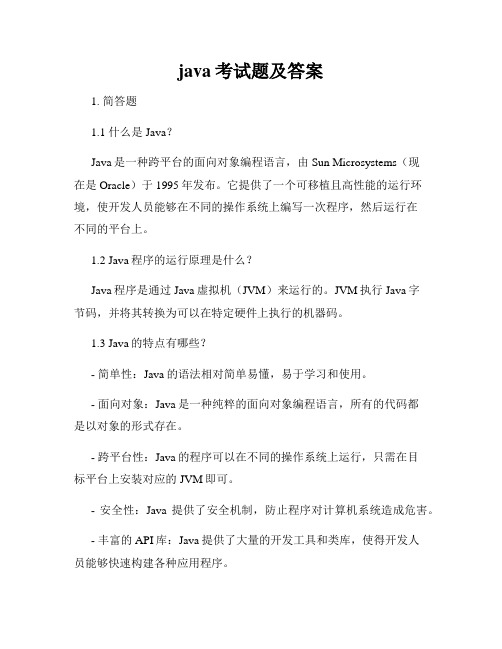
java考试题及答案1. 简答题1.1 什么是Java?Java是一种跨平台的面向对象编程语言,由Sun Microsystems(现在是Oracle)于1995年发布。
它提供了一个可移植且高性能的运行环境,使开发人员能够在不同的操作系统上编写一次程序,然后运行在不同的平台上。
1.2 Java程序的运行原理是什么?Java程序是通过Java虚拟机(JVM)来运行的。
JVM执行Java字节码,并将其转换为可以在特定硬件上执行的机器码。
1.3 Java的特点有哪些?- 简单性:Java的语法相对简单易懂,易于学习和使用。
- 面向对象:Java是一种纯粹的面向对象编程语言,所有的代码都是以对象的形式存在。
- 跨平台性:Java的程序可以在不同的操作系统上运行,只需在目标平台上安装对应的JVM即可。
- 安全性:Java提供了安全机制,防止程序对计算机系统造成危害。
- 丰富的API库:Java提供了大量的开发工具和类库,使得开发人员能够快速构建各种应用程序。
2. 选择题2.1 下面哪个选项不是Java的基本数据类型?A. intB. floatC. booleanD. String答案:D. String2.2 下面哪个关键字用于定义一个类?A. classB. publicC. voidD. static答案:A. class2.3 下面哪个选项可以用于创建一个数组?A. classB. newC. publicD. void答案:B. new3. 编程题3.1 编写一个Java程序,计算并输出1到100之间所有偶数的和。
```javapublic class EvenSum {public static void main(String[] args) {int sum = 0;for (int i = 1; i <= 100; i++) {if (i % 2 == 0) {sum += i;}}System.out.println("1到100之间所有偶数的和为:" + sum); }}```4. 解答题4.1 简要解释Java的继承机制。
Java考试题+答案

选择题(每题3分,共45分)1、下列程序编译或运行的结果是。
() Dpublic static void main(String args[]){int a = 10;int b,c;if(a>50){b=9;}c = b + a;System。
out.println(c);}A。
10 B。
19 C. 9 D. 编译错误2、下列语句片段中,four的值为 ( ) Dint three = 3;char one = ‘1’;char four = (char)(three+one);A。
3 B。
1 C。
31 D。
43、下列代码的运行结果是() Dpublic static void main(String[] args){int a = 7;System。
out。
println(a%3);}A.2.0 B.2 C.1.0 D.14、以下程序的输出结果为()。
Dpublic static void main(String[] args){int x = 1, y = 1, z =1;if(x——==1&&y—-==1||z-—==1)System。
out.println(“x=” +x+”, y=” +y+”, z=” +z);}A。
x=0, y=1, z=1B. x=0, y=2, z=2C。
x=0, y=2, z=1D. x=0, y=0, z=15、下列代码段编译和运行的结果是(). Cpublic static void main(String args[]){String str = “null”;if(str==null){System.out.println(“null”);}else if(str.length()==0){System.out.println(“zero”);}else {System.out.println(“some”);}}A。
Java考试试题
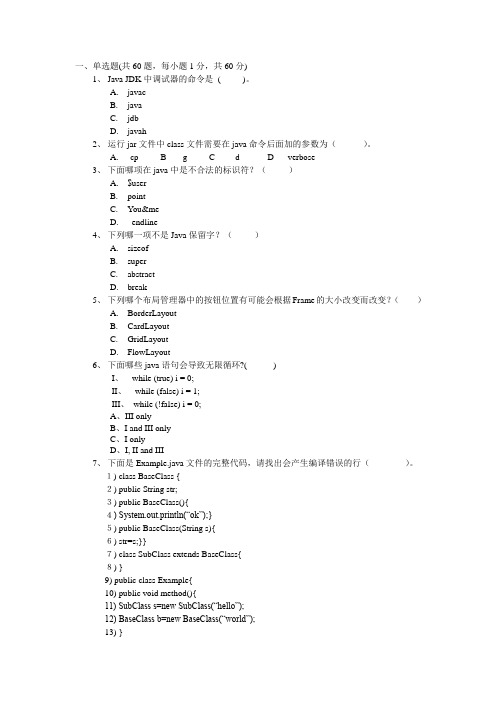
一、单选题(共60题,每小题1分,共60分)1、Java JDK中调试器的命令是( )。
A.javacB.javaC.jdbD.javah2、运行jar文件中class文件需要在java命令后面加的参数为()。
A.-cp B -g C -d D -verbose3、下面哪项在java中是不合法的标识符?()A.$userB.pointC.You&meD._endline4、下列哪一项不是Java保留字?()A.sizeofB.superC.abstractD.break5、下列哪个布局管理器中的按钮位置有可能会根据Frame的大小改变而改变?()A.BorderLayoutB.CardLayoutC.GridLayoutD.FlowLayout6、下面哪些java语句会导致无限循环?( )I、while (true) i = 0;II、while (false) i = 1;III、while (!false) i = 0;A、III onlyB、I and III onlyC、I onlyD、I, II and III7、下面是Example.java文件的完整代码,请找出会产生编译错误的行()。
1) class BaseClass {2) public String str;3) public BaseClass(){4) System.out.println(“ok”);}5) public BaseClass(String s){6) str=s;}}7) class SubClass extends BaseClass{8) }9) public class Example{10) public void method(){11) SubClass s=new SubClass(“hello”);12) BaseClass b=new BaseClass(“world”);13) }14) }A.7B.10C.11D.128、可以在下面代码段point x处写入的是()。
Java考试题
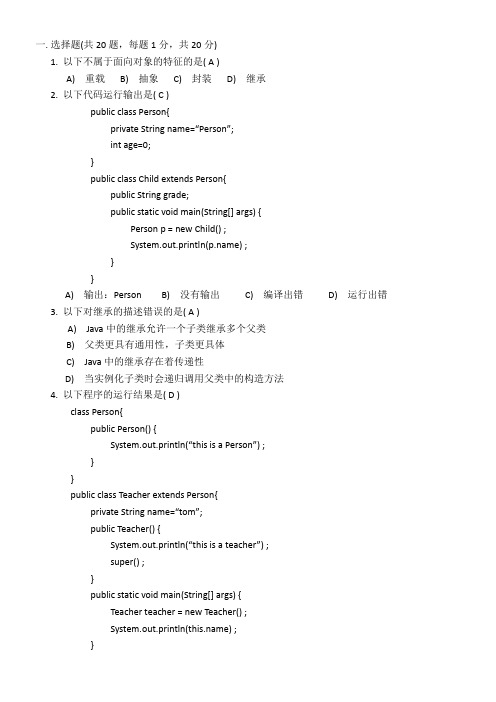
一.选择题(共20题,每题1分,共20分)1. 以下不属于面向对象的特征的是( A )A) 重载B) 抽象C) 封装D) 继承2. 以下代码运行输出是( C )public class Person{private String name=“Person”;int age=0;}public class Child extends Person{public String grade;public static void main(String[] args) {Person p = new Child() ;System.out.println() ;}}A) 输出:Person B) 没有输出C) 编译出错D) 运行出错3. 以下对继承的描述错误的是( A )A) Java中的继承允许一个子类继承多个父类B) 父类更具有通用性,子类更具体C) Java中的继承存在着传递性D) 当实例化子类时会递归调用父类中的构造方法4. 以下程序的运行结果是( D )class Person{public Person() {System.out.println(“this is a Person”) ;}}public class Teacher extends Person{private String name=“tom”;public Teacher() {System.out.println(“this is a teacher”) ;super() ;}public static void main(String[] args) {Teacher teacher = new Teacher() ;System.out.println() ;}}A) this is a Personthis is a teachertomB) this is a teacherthis is a PersontomC) 运行出错D) 编译有两处错误5.关于sleep()和wait(),以下描述错误的一项是( D )A) sleep是线程类(Thread)的方法,wait是Object类的方法;B) sleep不释放对象锁,wait放弃对象锁;C) sleep暂停线程、但监控状态仍然保持,结束后会自动恢复;D) wait后进入等待锁定池,只有针对此对象发出notify方法后获得对象锁进入运行状态。
java基础入门考试题目及答案
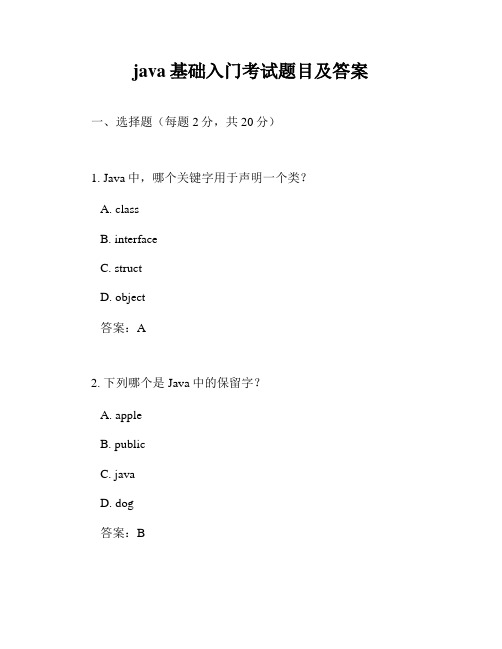
java基础入门考试题目及答案一、选择题(每题2分,共20分)1. Java中,哪个关键字用于声明一个类?A. classB. interfaceC. structD. object答案:A2. 下列哪个是Java中的保留字?A. appleB. publicC. javaD. dog答案:B3. Java中,哪个方法用于获取字符串的长度?A. length()B. size()C. count()D. length答案:A4. 在Java中,哪个关键字用于定义一个方法?A. functionB. methodC. defD. void答案:D5. Java中,哪个关键字用于声明一个接口?A. classB. interfaceC. structD. object答案:B6. Java中,哪个关键字用于声明一个包?A. packageB. importC. classD. public答案:A7. Java中,哪个关键字用于实现多重继承?A. extendsB. implementsC. extends and implementsD. None of the above答案:B8. 在Java中,哪个关键字用于声明一个变量?A. varB. letC. defD. val答案:A9. Java中,哪个关键字用于声明一个常量?A. finalB. constC. staticD. var答案:A10. 在Java中,哪个关键字用于抛出一个异常?A. throwB. throwsC. catchD. try答案:B二、填空题(每题2分,共20分)1. Java是一种_________语言,它支持跨平台运行。
答案:面向对象2. Java程序的执行入口是_________方法。
答案:main3. 在Java中,所有的类都是_________类的子类。
答案:Object4. Java中,用于声明一个私有方法的关键字是_________。
java考试题及答案
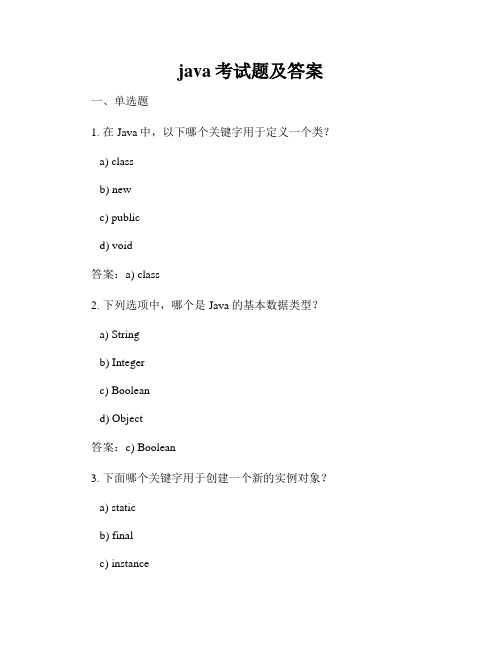
java考试题及答案一、单选题1. 在Java中,以下哪个关键字用于定义一个类?a) classb) newc) publicd) void答案:a) class2. 下列选项中,哪个是Java的基本数据类型?a) Stringb) Integerc) Booleand) Object答案:c) Boolean3. 下面哪个关键字用于创建一个新的实例对象?a) staticb) finalc) instance答案:d) new4. Java中的继承是指什么?a) 一个类实现另一个类的属性和方法b) 一个类派生出另一个类,新类拥有原来类的属性和方法c) 一个类使用另一个类的属性和方法d) 一个类包含另一个类的属性和方法答案:b) 一个类派生出另一个类,新类拥有原来类的属性和方法5. 在Java中,以下哪个关键字用于声明一个变量不可修改?a) constantb) finalc) staticd) abstract答案:b) final二、多选题1. 以下哪些操作符可以用于控制流程?a) ifb) ford) switch答案:a) ifb) forc) whiled) switch2. Java中的异常处理机制包括以下哪些部分?a) tryb) catchc) throwd) finally答案:a) tryb) catchd) finally三、简答题1. 请简要解释Java中的多态性是什么意思。
答案:Java中的多态性是指同一个接口,能够有多个不同的实现类。
通过多态性,可以实现方法的动态绑定,在运行时根据具体的对象类型调用相应的方法。
这样可以提高代码的灵活性和可扩展性。
2. 请解释Java中的访问修饰符public、protected、private和default之间的区别。
答案:public修饰的成员变量或方法可以在任何地方被访问;protected修饰的成员变量或方法可以被子类和同一个包内的类访问;private修饰的成员变量或方法只能在当前类中被访问;default修饰的成员变量或方法可以在同一个包内被访问。
java考试题及答案
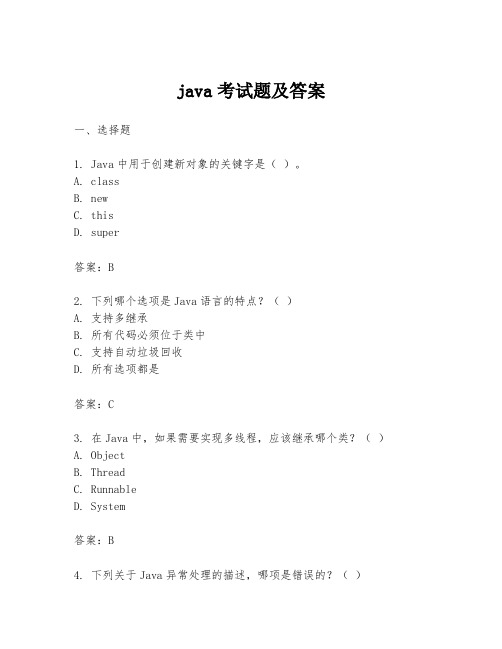
java考试题及答案一、选择题1. Java中用于创建新对象的关键字是()。
A. classB. newC. thisD. super答案:B2. 下列哪个选项是Java语言的特点?()A. 支持多继承B. 所有代码必须位于类中C. 支持自动垃圾回收D. 所有选项都是答案:C3. 在Java中,如果需要实现多线程,应该继承哪个类?()A. ObjectB. ThreadC. RunnableD. System答案:B4. 下列关于Java异常处理的描述,哪项是错误的?()A. try块可以单独使用B. catch块必须跟随在try块之后C. finally块用于执行清理操作,无论是否发生异常都会执行D. throw关键字用于手动抛出异常答案:A5. 在Java中,下列哪个是正确的数组初始化方式?()A. int[] arr = {1, 2, 3} {4, 5, 6};B. int[] arr = new int[3];C. int[] arr = new int[] {1, 2, 3};D. int[] arr = {1, 2, 3, 4, 5};答案:C二、填空题1. 在Java中,每一个类都是从______类隐式继承而来的,因此所有的类都具有该类的属性和方法。
答案:Object2. Java中的______关键字用于定义一个类为另一个类的子类,实现代码的复用。
答案:extends3. 当需要在Java程序中捕获多种类型的异常时,可以使用______关键字来指定多个捕获类型。
答案:catch4. 在Java中,______关键字用于定义一个方法或构造器的参数类型和顺序。
答案:paramter5. 如果需要在Java中定义一个接口,应该使用______关键字。
答案:interface三、判断题1. Java中的所有异常都是ng包的Throwable类的子类或孙子类。
()答案:正确2. 在Java中,所有的类都必须显式地指定一个父类。
java编程基础考试题
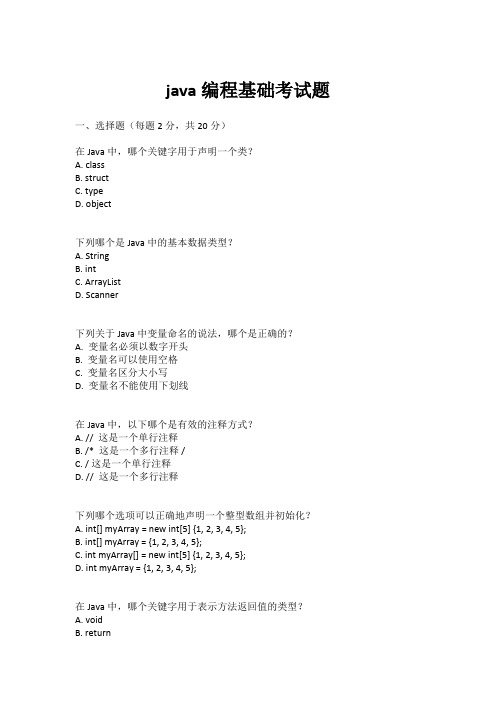
java编程基础考试题一、选择题(每题2分,共20分)在Java中,哪个关键字用于声明一个类?A. classB. structC. typeD. object下列哪个是Java中的基本数据类型?A. StringB. intC. ArrayListD. Scanner下列关于Java中变量命名的说法,哪个是正确的?A. 变量名必须以数字开头B. 变量名可以使用空格C. 变量名区分大小写D. 变量名不能使用下划线在Java中,以下哪个是有效的注释方式?A. // 这是一个单行注释B. /* 这是一个多行注释 /C. / 这是一个单行注释D. // 这是一个多行注释下列哪个选项可以正确地声明一个整型数组并初始化?A. int[] myArray = new int[5] {1, 2, 3, 4, 5};B. int[] myArray = {1, 2, 3, 4, 5};C. int myArray[] = new int[5] {1, 2, 3, 4, 5};D. int myArray = {1, 2, 3, 4, 5};在Java中,哪个关键字用于表示方法返回值的类型?A. voidB. returnC. typeD. returnType下列哪个是Java中的条件语句?A. forB. ifC. whileD. switch下列关于Java中System.out.println()方法的说法,哪个是正确的?A. 它用于从控制台读取输入B. 它用于在控制台输出文本C. 它用于在控制台显示错误消息D. 它用于在控制台显示警告消息在Java中,String类型的数据以下列哪种方式声明?A. string myString = "Hello";B. String myString = new String("Hello");C. string myString = new String("Hello");D. String = "Hello";下列关于Java中静态方法(static method)的说法,哪个是正确的?A. 静态方法只能访问静态变量B. 静态方法不能被实例对象调用C. 静态方法不能包含非静态方法D. 静态方法只能在类加载时被调用一次二、填空题(每题2分,共10分)在Java中,一个类通常包含_______、字段(属性)和方法。
JAVA考试题

01 java技术入门一、选择题Java 运行平台包括三个版本,请选择错误的一项:(D)A. J2EEB. J2MEC. J2SED. J2E2.Java JDK 中反编译工具是:(D)A.javac B. javaC. jdbD. javap3.在Java中,关于CLASSPATH环境变量的说法不正确的是:()A. CLASSPATH一旦设置之后不可修改,但可以将目录添加到该环境变量中。
B. 编译器用它来搜索各自的类文件。
C. CLASSPATH是一个目录列表。
D. 解释器用它来搜索各自的类文件。
4. 面向对象的三大特性不包括(D)A.封装B.继承C .多态D .消息通信5.下列选项中不属于Java虚拟机的执行特点的一项是(D):A.异常处理B.多线程C.动态链接D.简单易学6.下列定义语句正确的是:(B)A.char c="\n"; B.int i=12;C.float f=2.8; D.boolean b=null;7.main方法是java Application 程序执行的入口点,关于main方法的方法头以下( B) 是合法的。
A. public static void main()B. public static void main(String[]args)C. public static intmain(String[]arg)D. public void main(String arg[]8.编译Java Application 源文件将产生相应的字节码文件,扩展名为(B)。
A. javaB. classC. htmlD. exe二、填空题1.开发与运行Java程序需要经过的三个主要步骤为编辑源程序、编译生成字节码和解释运行字节码。
2.定义包的关键字是Package。
3.每个Java应用程序可以包括许多方法,但必须有且只能有一个main方法。
4.声明1个名称“count”的整形变量的语句为声明1个名称“count”的整形变量的语句为int count 。
java期末考试题试题库及答案
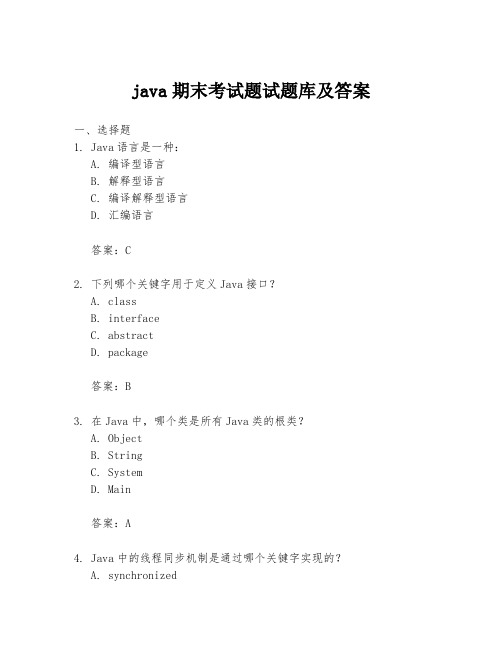
java期末考试题试题库及答案一、选择题1. Java语言是一种:A. 编译型语言B. 解释型语言C. 编译解释型语言D. 汇编语言答案:C2. 下列哪个关键字用于定义Java接口?A. classB. interfaceC. abstractD. package答案:B3. 在Java中,哪个类是所有Java类的根类?A. ObjectB. StringC. SystemD. Main答案:A4. Java中的线程同步机制是通过哪个关键字实现的?A. synchronizedB. volatileC. finalD. static答案:A5. 下列哪个不是Java集合框架中的一部分?A. ListB. SetC. MapD. Queue答案:D二、填空题6. Java语言的跨平台特性主要得益于______机制。
答案:JVM(Java虚拟机)7. 在Java中,______关键字用于定义一个方法不能被重写。
答案:final8. Java的异常处理机制中,______类是所有异常的超类。
答案:Throwable9. Java中的______关键字用于声明一个变量,其值在初始化后不能被改变。
答案:final10. 一个Java程序的入口点是______方法。
答案:main三、简答题11. 简述Java中接口和抽象类的区别。
答案:接口定义了一组方法规范,不包含实现,可以被任何类实现,而抽象类可以包含方法实现,并且可以被其他类继承。
接口不能有构造方法,而抽象类可以有。
接口中的方法默认是public和abstract的,而抽象类中可以有public、private等访问修饰符。
12. 描述Java中异常处理的机制。
答案:Java的异常处理机制包括try、catch、finally和throw 关键字。
try块用于包含可能抛出异常的代码,catch块用于捕获并处理异常,finally块用于执行无论是否发生异常都需要执行的代码。
java考试题及答案
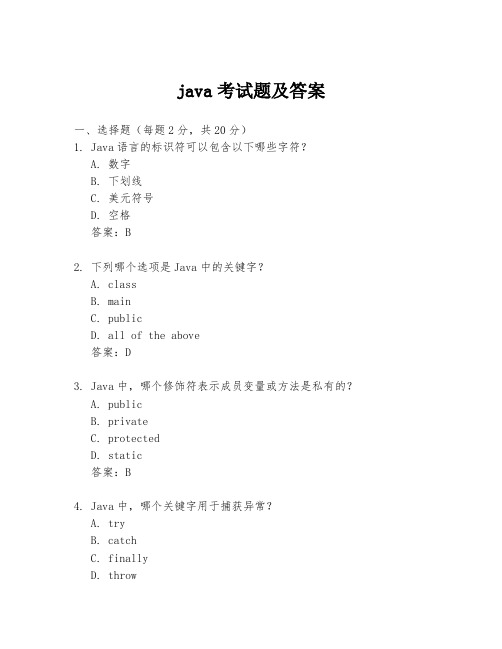
java考试题及答案一、选择题(每题2分,共20分)1. Java语言的标识符可以包含以下哪些字符?A. 数字B. 下划线C. 美元符号D. 空格答案:B2. 下列哪个选项是Java中的关键字?A. classB. mainC. publicD. all of the above答案:D3. Java中,哪个修饰符表示成员变量或方法是私有的?A. publicB. privateC. protectedD. static答案:B4. Java中,哪个关键字用于捕获异常?A. tryB. catchC. finallyD. throw答案:B5. 在Java中,下列哪个数据类型是基本数据类型?A. StringB. intC. ArrayListD. HashMap答案:B6. 下列哪个选项不是Java集合框架的一部分?A. ListB. MapC. SetD. String答案:D7. Java中,哪个关键字用于定义接口?A. classB. interfaceC. abstractD. final答案:B8. 在Java中,下列哪个选项不是线程安全的?A. VectorB. ArrayListC. LinkedListD. HashMap答案:B9. Java中,下列哪个选项是正确的继承关系?A. Object is a subclass of StringB. String is a subclass of ObjectC. Object is a superclass of StringD. String is a superclass of Object答案:B10. 下列哪个选项不是Java中的访问修饰符?A. publicB. privateC. protectedD. global答案:D二、填空题(每题2分,共20分)1. Java中,用于定义类的关键字是______。
答案:class2. Java中,用于定义接口的关键字是______。
java考试

编程题,每题5分1.编程计算N的累加(求1+2+..+n的和)的程序,一个使用递归方法,一个不用递归方法2.编程显示某一文件目录下的所有文件名;public void showName(File f){}3.定义一个文件d:/info.txt,在文件中存储2行文本,写一个程序,读取文件中的全部文本(使用BufferedReader);4.定义一个方法,功能是从10个人名中随机挑出5个人名,并输出(5分)Public void pickNames();5.设计两个个线程模拟存取款操作,其中一个线程每次随机存1~1000元钱,另外一个线程取1-1000元钱,如果余额不足,则取款失败,提示余额不足。
写出程序(考虑并发问题)。
6.制作一个字符串数组,每个元素都有一些随意输入的数字和字母组成,要求找出里面每个数字,然后求出他们的和,比如{"adf1f23","ju34ui21"}第一个元素的数字是123,第二个数字是3421他们的和是3421+123 =3544;7.定义一个学生类Student,属性有age(年纪),name(姓名),score (分数),实例化6个对象,放在集合中,.有如下Student 对象其中,classNum 表示学生的班号,例如“class05”。
有如下ListList list = new ArrayList();list.add(new Student(“Tom”, 18, 100, “class05”));list.add(new Student(“Jerry”, 22, 70, “class04”));list.add(new Student(“Owen”, 25, 90, “class05”));list.add(new Student(“Jim”, 30,80 , “class05”));list.add(new Student(“Steve”, 28, 66, “class06”));list.add(new Student(“Kevin”, 24, 100, “class04”));在这个list 的基础上,完成下列要求:1)统计出总班级数2)统计每个班级的平均分和人数3)按学生的成绩排序(成绩相同按年纪)排序输出;8.有一个ArrayList集合,集合中的元素分别{1,2,3,6,8,7,7,8,2,2,1,2},将重复的数字找到,并按数字的大小排序输出输出,格式是1:2次2:4次3:1次6:1次7:3次8:2次。
java考试题及答案
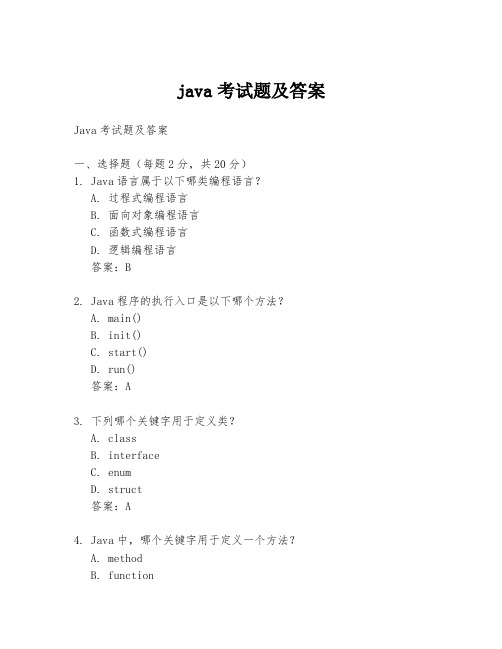
java考试题及答案Java考试题及答案一、选择题(每题2分,共20分)1. Java语言属于以下哪类编程语言?A. 过程式编程语言B. 面向对象编程语言C. 函数式编程语言D. 逻辑编程语言答案:B2. Java程序的执行入口是以下哪个方法?A. main()B. init()C. start()D. run()答案:A3. 下列哪个关键字用于定义类?A. classB. interfaceC. enumD. struct答案:A4. Java中,哪个关键字用于定义一个方法?A. methodB. functionC. procedureD. void答案:D5. 在Java中,哪个关键字用于实现继承?A. extendsB. inheritC. derivedD. subclass答案:A6. 下列哪个是Java中的访问修饰符?A. publicB. privateC. protectedD. All of the above答案:D7. Java中,哪个关键字用于抛出异常?A. tryB. catchC. throwD. finally答案:C8. Java中,哪个类是所有Java类的父类?A. ObjectB. ClassC. SystemD. Thread答案:A9. 在Java中,哪个关键字用于定义接口?A. classB. interfaceC. abstractD. package答案:B10. 下列哪个是Java集合框架中的接口?A. ListB. SetC. MapD. All of the above答案:D二、简答题(每题10分,共30分)1. 简述Java的垃圾回收机制。
答案:Java的垃圾回收机制是一种自动内存管理功能,它通过垃圾回收器定期检查不再被引用的对象,并释放它们占用的内存。
垃圾回收器运行在后台,开发者不需要手动释放对象内存。
2. 描述Java中多态的概念及其实现方式。
java考试试题及答案
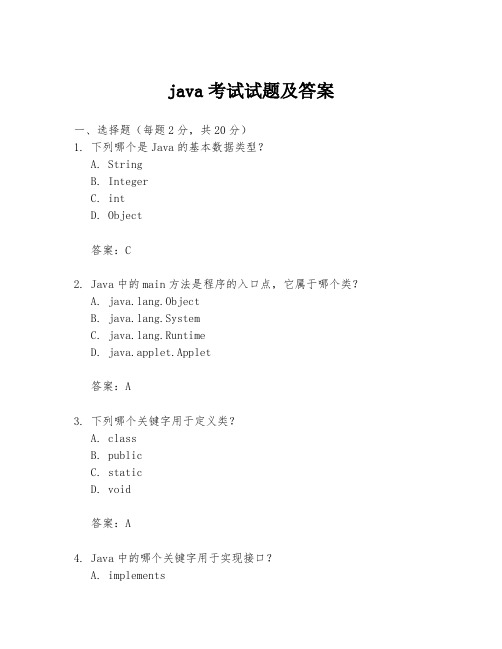
java考试试题及答案一、选择题(每题2分,共20分)1. 下列哪个是Java的基本数据类型?A. StringB. IntegerC. intD. Object答案:C2. Java中的main方法是程序的入口点,它属于哪个类?A. ng.ObjectB. ng.SystemC. ng.RuntimeD. java.applet.Applet答案:A3. 下列哪个关键字用于定义类?A. classB. publicC. staticD. void答案:A4. Java中的哪个关键字用于实现接口?A. implementsB. extendsC. classD. interface答案:A5. 下列哪个是Java集合框架中的接口?A. ArrayListB. ListC. LinkedListD. HashMap答案:B6. 下列哪个不是Java的控制流语句?A. ifB. forC. switchD. while答案:C7. Java中的哪个类提供了日期和时间的处理功能?A. java.util.DateB. java.util.CalendarC. java.time.LocalDateD. java.time.LocalDateTime答案:B8. 下列哪个是Java的异常处理关键字?A. tryB. catchC. finallyD. all of the above答案:D9. 下列哪个不是Java的访问修饰符?A. publicB. privateC. protectedD. global答案:D10. 下列哪个不是Java的注释方式?A. // 单行注释B. /* 多行注释 */C. / 文档注释 */D. # 预处理指令答案:D二、填空题(每空2分,共20分)1. Java语言是________面向对象的编程语言。
答案:完全2. Java程序的执行流程是:编写源代码,编译成字节码,通过________加载并执行。
Java考试题
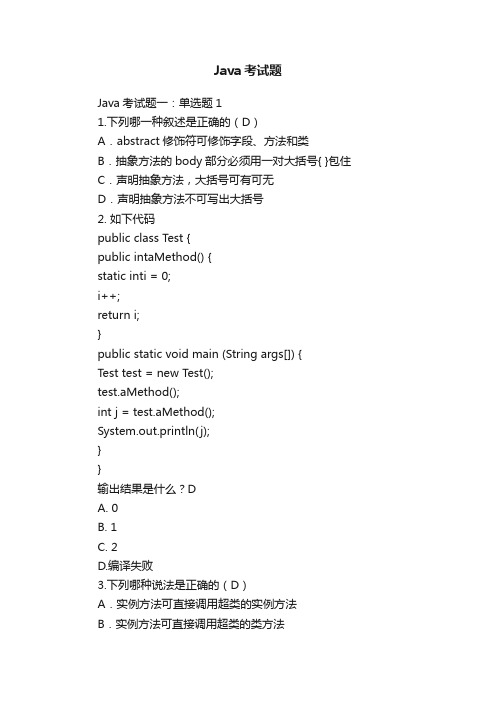
Java考试题Java考试题一:单选题11.下列哪一种叙述是正确的(D)A.abstract修饰符可修饰字段、方法和类B.抽象方法的body部分必须用一对大括号{ }包住C.声明抽象方法,大括号可有可无D.声明抽象方法不可写出大括号2. 如下代码public class Test {public intaMethod() {static inti = 0;i++;return i;}public static void main (String args[]) {Test test = new Test();test.aMethod();int j = test.aMethod();System.out.println(j);}}输出结果是什么?DA. 0B. 1C. 2D.编译失败3.下列哪种说法是正确的(D)A.实例方法可直接调用超类的实例方法B.实例方法可直接调用超类的类方法C.实例方法可直接调用其他类的实例方法D.实例方法可直接调用本类的类方法4.如下代码:class Super {public Integer getLenght() { return new Integer(4); }}public class Sub extends Super {public Long getLenght() { return new Long(5); } public static void main(String[] args) {Super sooper = new Super();Sub sub = new Sub();System.out.println(sooper.getLenght().toString() + "," + sub.getLenght().toString() );}}输出是什么?AA. 4,4B. 4,5C. 5,4D. 5,5E. 编译失败.---------重定时不能改变返回类型5.在Servlet处理请求的方式为:CA.以进程的方式B.以程序的方式C.以线程的方式D.以响应的方式6. JDBC中,用于表示数据库连接的对象是:BA.StatementB.ConnectionC.DriverManagerD.PreparedStatement7.用于调用存储过程的对象是:CA.ResultSetB.DriverManagerC.CallableStatemetD.PreparedStatement8.按照MVC设计模式,JSP用于实现:BA.ModelB.ViewC.ControllerD.容器9.如下代码10. public Object m() {11. Object o = new Float(3.14F);12. Object [] oa = new Object[1];13. oa[0] = o;14. o = null;15. oa[0] = null;16. print 'return 0';17. }当Float对象在第11行被创建后, 什么时候能够被垃圾回收?CA. 13行以后.B. 14行以后.C. 15行以后.D. 16行以后.10.如下代码:class Base {Base() { System.out.print("Base"); }}public class Alpha extends Base {public static void main( String[] args ) {new Alpha();-----调用父类无参的构造方法new Base();}}结果是什么?BA. BaseB. BaseBaseC. 编译失败.D. 代码运行但没有输出.E. 运行时抛出异常11.在J2EE中属于Web层的组件有:AA.ServletB.EJBC.AppletD.HTML12.在Servlet的生命周期中,容器只调用一次的方法是:CA.serviceB.getServletConfigC.initD.destroy13.以下关于异常的说法正确的是:DA. 一旦出现异常,程序运行就终止了B. 如果一个方法申明将抛出某个异常,它就必须真的抛出那个异常C. 在catch子句中匹配异常是一种精确匹配D. 可能抛出系统异常的方法是不需要申明异常的14.如下代码:public class Foo {public static void main(String[] args) {try {return;} finally {System.out.println( "Finally" );}}}输出结果是什么?AA. FinallyB.编译失败C. 代码正常运行但没有任何输出.D. 运行时抛出异常15. jsp指令中isELIgnored="boolean"的意思是(C)A.决定是否实现Servler的单线程模式,B.决定改页面是否是一个错误处理页面,C.决定是否支持EL表示,D.没有具体的含义。
java基础考试题

java基础考试题一、选择题1. 在Java中,以下关键字用于声明一个类的是:A. classB. objectC. variableD. method2. 下列哪个选项是合法的Java标识符:A. 123identifierB. _identifierC. identifier$D. identifier+3. 下列哪个选项是Java的基本数据类型:A. StringB. IntegerC. DoubleD. Boolean4. 在Java中,以下哪个关键字用于定义一个常量:A. staticB. finalC. abstractD. void5. 下列哪个选项是Java中的循环结构:A. if-elseB. for-eachC. switch-caseD. try-catch二、填空题6. Java中的随机数生成器类是______。
7. 下划线 "_"是Java 8中引入的一个新特性,主要用于______。
8. 在Java中,通过使用______关键字,可以终止当前循环执行。
9. 在Java中,______关键字用于声明一个方法,该方法不返回任何值。
三、简答题10. Java是平台无关的编程语言,请说明这句话的含义。
四、编程题编写一个Java程序,实现以下功能:- 定义一个叫做Rectangle的类,包含属性:长(length)和宽(width),还包含计算矩形面积的方法。
- 在主函数中,创建一个Rectangle对象,并设置其长和宽为5和3。
然后调用计算面积的方法,并将结果打印输出。
以上是关于Java基础考试题的内容。
希望对你有所帮助!。
- 1、下载文档前请自行甄别文档内容的完整性,平台不提供额外的编辑、内容补充、找答案等附加服务。
- 2、"仅部分预览"的文档,不可在线预览部分如存在完整性等问题,可反馈申请退款(可完整预览的文档不适用该条件!)。
- 3、如文档侵犯您的权益,请联系客服反馈,我们会尽快为您处理(人工客服工作时间:9:00-18:30)。
System.out.println(s);
}
如果程序输出的结果是4247,那么在<插入代码>处应该填入代码是()。
A.
String s = "123456789";
s = (s-"123").replace(1,3,"24") - "89";
Java访问修饰符按照访问范围由低到高的排列顺序是public,default,protecБайду номын сангаасed,private
B.
private可以用于外部类的声明
C.
一个Java源文件中声明为public的外部类只能有一个
D.
protected声明的方法不可以被子类重写
3.
请看下列代码
TCSD——标准考试 2014年09月_JSD_JSD1408试题
(100分制,考试时间150分钟)
一、 单选(35小题共70.0分)
1.
关于下列代码说法不正确的是:
10. interface Foo {
11. int bar();
12. }
13.
14. public class Beta {
public interface A {
String DEFAULT_GREETING = "Hello World";
public void method1();
}
现有接口B,是A接口的子接口,下列选择中B接口的声明正确的是:
A.
public interface B extends A { }
this.numberOfinstances = numberOfinstances;
}
public class B extends A {
public void start() {
System.out.println("TestB");
}
public static void main(String[] args) {
((A) new B()).start();
public class Member{
private Long userId;
private String nickName;
//以下是getter和sett方法
……
}
Main方法中的代码:
Member m1=new Member();
m1.setUserId(new Long(100001));
public void f() {
System.out.println("B.f()");
}
}
public class C {
public void g(A a) {
System.out.println("g(A a)");
a.f();
11.
请看下列代码编译和运行的结果是()。
interface DeclareStuff {
public static final int EASY = 3;
void doStuff(int t);
}
public class TestDeclare implements DeclareStuff {
15.
16. class A implements Foo {
17. public int bar() { return 1; }
18. }
19.
20. public int fubar( Foo foo) { return foo.bar(); }
21.
22. public void testFoo() {
}
}
A.
s=14
B.
s=16
C.
s=10
D.
编译失败
12.
类A,B和C的定义如下:
public class A {
public void f() {
System.out.println("A.f()");
}
}
public class B extends A {
B.
StringBuffer s = new StringBuffer("123456789");
s.delete(0,3).replace( 1,3, "24").delete(4,6);
C.
StringBuffer s = new StringBuffer("123456789");
m1.setNickName(“mick”);
Member m2=new Member();
m2.setUserId(new Long(100001));
m2.setNickName(“mick”);
System.out.println(m1==m2);
System.out.println(m1.equals(m2));
32. new Beta().testFoo();
33. }
34. }
A.
编译错误
B.
运行代码输出:2
C.
如果删除16,17,18行,运行代码应然输出:2
D.
如果删除24,25,26行,运行代码输出:1
2.
在Java语言中,下列说法正确的是:()。
A.
C.
当引用到使用static final 修饰的常量时,将采用编译期绑定的方式。
D.
当使用final和abstract共同修饰一个类时,final应至于abstract之前。
5.
下列代码的输出结果是()
public static void main(String[] args) {
s.substring(3,6).delete( 1 ,3).insert( 1, "24");
D.
StringBuilder s = new StringBuilder("123456789");
s.substring(3,6).delete( 1 ,2).insert( 1, "24");
String test = "a1b2c3";
String[] tokens = test.split("\\d");
for (String s : tokens)
System.out.print(s + " ");
}
A.
g(A a)
A.f()
B.
g(A a)
B.f()
C.
g(B b)
A.f()
D.
g(B b)
B.f()
13.
程序的执行结果是:
public class Test {
public static void main(String [] args){
23.
24. class A implements Foo {
25. public int bar() { return 2; }
26. }
27.
28. System.out.println( fubar( new A()));
29. }
30.
31. public static void main( String[] argv) {
System.out.println(“”+'a'+1);
}
}
A.
98
B.
a1
C.
971
D.
197
14.
下列语句创建对象的总个数是:()。
String s=”a”+”b”+”c”+”d”+”e”;
A.
1
B.
2
}
public void g(B b) {
System.out.println("g(B b)");
b.f();
}
}
运行下面程序:
C c = new C();
A a = new B();
c.g(a);
输出的结果是:()。
return super.getCountry();
}
}
A.
Yen类编译正确
B.
Euro类编译正确
C.
Money类编译错误
D.
Yen和Money编译错误
7.
在Java中,Integer.MAX_VALUE表示:
A.
double型最大值
B.
C.
public void Card(){}
D.
private Card(){}
17.
下列代码编译和运行的结果是()。
public class A {
public void start() {
System.out.println("TestA");
}
A.
a b c
B.
1 2 3
C.
a1b2c3
D.
a1 b2 c3
